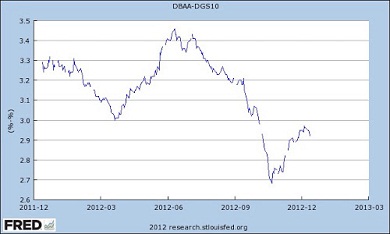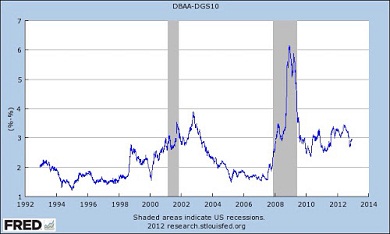The spread between the public and the corporate bond translates investors’ confidence and expectations into a clear picture. When the premium is low because the Treasury paper needs to offer higher returns against the corporate debt, capital is being allocated on the private sector, which would bear an attractive enough risk weight. After the Federal Reserve promised minimum interest rates and liquidity injections until unemployment falls down to 6.5 percent or inflation raises above 2.5 percent, corporate risk aversion among investors has began to recede.
Will it be sufficient to effectively fight jobless levels and reach a stronger, more sustainable economic growth? The truth is, look at the second chart, we all are far from that point.
During the 90s and partially in the 2000s, our indicator was below 2 percent. Investors felt reassured by private sectors’ behaviour. Now, though, the indicator is over 2.9 percent, after having dropped to 2.7 percent from 3.4 percent in summer.
What’s happened? The impact of the Draghi bluff was written off by the markets. The governor of the European Central Bank promised to back up short term debt sales of peripheral euro country members–a mechanism that hasn’t been used, so far. Then, the US Federal Reserve’s Ben Bernanke renewed his plans of intervention–which will been implemented as they have been in the past. But this announcement’s progress has been limited.
Let me saying once more: the US will stabilise if the EU does. And we are definitely not there.







Be the first to comment on "Draghi is a drag on Bernanke"